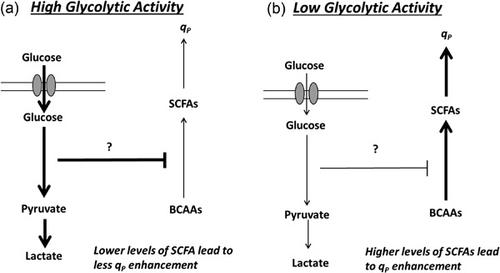当前位置:
X-MOL 学术
›
Biotechnol. Bioeng.
›
论文详情
Our official English website, www.x-mol.net, welcomes your
feedback! (Note: you will need to create a separate account there.)
Production of butyrate and branched-chain amino acid catabolic byproducts by CHO cells in fed-batch culture enhances their specific productivity
Biotechnology and Bioengineering ( IF 3.5 ) Pub Date : 2021-09-27 , DOI: 10.1002/bit.27942 Cameron Harrington 1 , Michaela Jacobs 1 , Quentin Bethune 1 , Taylor Kalomeris 1 , Gregory W Hiller 1 , Bhanu Chandra Mulukutla 1
Biotechnology and Bioengineering ( IF 3.5 ) Pub Date : 2021-09-27 , DOI: 10.1002/bit.27942 Cameron Harrington 1 , Michaela Jacobs 1 , Quentin Bethune 1 , Taylor Kalomeris 1 , Gregory W Hiller 1 , Bhanu Chandra Mulukutla 1
Affiliation

|
Chinese hamster ovary (CHO) cells in fed-batch cultures produce several metabolic byproducts derived from amino acid catabolism, some of which accumulate to growth inhibitory levels. Controlling the accumulation of these byproducts has been shown to significantly enhance cell proliferation. Interestingly, some of these byproducts have physiological roles that go beyond inhibition of cell proliferation. In this study, we show that, in CHO cell fed-batch cultures, branched-chain amino acid (BCAA) catabolism contributes to the formation of butyrate, a novel byproduct that is also a well-established specific productivity enhancer. We further show that other byproducts of BCAA catabolism, namely isovalerate and isobutyrate, which accumulate in CHO cell fed-batch cultures, also enhance specific productivity. Lastly, we show that the rate of production of these BCAA catabolic byproducts is negatively correlated with glucose uptake and lactate production rates. Thus, limiting glucose supply to suppress glucose uptake and lactate production, as in the case of fed-batch cultures employing high-end pH-controlled delivery of glucose (HiPDOG) technology, significantly enhances BCAA catabolic byproduct accumulation, resulting in higher specific productivities.
更新日期:2021-11-10











































 京公网安备 11010802027423号
京公网安备 11010802027423号